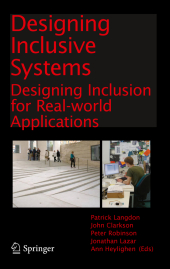 Neuerscheinungen 2014Stand: 2020-02-01 |
Schnellsuche
ISBN/Stichwort/Autor
|
Herderstraße 10
10625 Berlin
Tel.: 030 315 714 16
Fax 030 315 714 14
info@buchspektrum.de |

John Clarkson, Ann Heylighen, Patrick Langdon, Jonathan Lazar, Peter Robinson
(Beteiligte)
Designing Inclusive Systems
Designing Inclusion for Real-world Applications
Herausgegeben von Langdon, Patrick; Clarkson, John; Robinson, Peter; Lazar, Jonathan; Heylighen, Ann
2012. 2014. xviii, 238 S. 24 Tabellen. 235 mm
Verlag/Jahr: SPRINGER, BERLIN; SPRINGER, LONDON; SPRINGER 2014
ISBN: 1-447-15983-7 (1447159837)
Neue ISBN: 978-1-447-15983-4 (9781447159834)
Preis und Lieferzeit: Bitte klicken
The Cambridge Workshops on Universal Access and Assistive Technology (CWUAAT) are a series of workshops held at a Cambridge University College every two years. The workshop theme: "Designing inclusion for real-world applications" refers to the emerging potential and relevance of the latest generations of inclusive design thinking, tools, techniques, and data, to mainstream project applications such as healthcare and the design of working environments. Inclusive Design Research involves developing tools and guidance enabling product designers to design for the widest possible population, for a given range of capabilities.
There are five main themes:
Designing for the Real-World
Measuring Demand And Capabilities
Designing Cognitive Interaction with Emerging Technologies
Design for Inclusion
Designing Inclusive Architecture
In the tradition of CWUAAT, we have solicited and accepted contributions over a wide range of topics, both within individual themes and also across the workshop´s scope. We ultimately hope to generate more inter-disciplinary dialogues based on focused usage cases that can provide the discipline necessary to drive further novel research, leading to better designs. The aim is to impact industry and end-users as well governance and public design, thereby effectively reducing exclusion and difficulty in peoples´ daily lives and society.
1. Designing for Real-World Applications: Work and Healthcare.- 2. Designing Inclusive Assistive and Rehabilitation Systems.- 3. Measuring Product Demand and People´s Capabilities.- 4. Mainstreaming and Scaling Technology for Healthcare.- 5. Designing Cognitive Interaction with Emerging Technologies.- 6. Effective Engagement with Industry.- 7. Designing Inclusive Spaces: Architecture and Buildings.- 8. Collaborative and Participatory Design for Inclusion.- 9. Data Issues: Visualizing Inclusion: Mining of Profile Data.- 10. Legislation, Standards and Policy in Inclusive Design.


